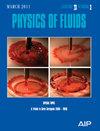论弗劳德数对通过巨石阵的明渠水流中的流动、湍流和水汽交换的作用
IF 4.1
2区 工程技术
Q1 MECHANICS
引用次数: 0
摘要
本文报告了在不同弗劳德数条件下明渠流经巨石阵列的数值模拟结果。模拟旨在阐明弗劳德数对水流、湍流和微流体交换的作用。在中低弗罗德数条件下,巨石顶部位于水面之上,巨石后的时间平均流向流速、雷诺切应力和湍流动能(TKE)相对较低。相反,在 Fr 值较高时,巨石被淹没,因此水流在巨石顶峰处分离,形成垂直再循环,并在下游河床上重新连接,导致巨石下游的雷诺切应力和 TKE 区域升高。观察到两种主要的湍流结构:(这些湍流结构在 x/D<2.0 的有限区域内影响着巨石下游的水汽交换。在其他位置,下沉流是由波长大于 2.9D 的巨石上游下沉流驱动的。最后,归一化的时间平均下垫面流量随 Fr 值的增加而增加,但在 Fr 值较高时,一旦溢流破坏了巨石尾流的形成,下垫面流量就会减少。本文章由计算机程序翻译,如有差异,请以英文原文为准。
On the role of the Froude number on flow, turbulence, and hyporheic exchange in open-channel flow through boulder arrays
In this paper, the results of numerical simulations of open-channel flow through boulder arrays at varying Froude numbers are reported. The simulations aim at clarifying the role of the Froude number on flow, turbulence, and hyporheic exchange. At low and intermediate Fr, the boulder top is above the water surface, and time-averaged streamwise flow velocity, Reynolds shear stresses, and the turbulent kinetic energy (TKE) are relatively low in the wake of boulders. Conversely, at high Fr values, the boulders are submerged, hence the flow separates at the boulder crest, creates vertical recirculation, and reattaches on the bed downstream, resulting in an area of elevated Reynolds shear stresses and TKE downstream of the boulders. Two dominant turbulence structures are observed: (i) flapping of boulder wakes with a characteristic length of 2.1 times the boulder diameter (D) at low and intermediate Fr and (ii) an upstream oriented hairpin vortex with a length scale of 1.0D at high Fr. These turbulence structures influence hyporheic exchange downstream of boulders within a limited region of x/D<2.0. In other locations, hyporheic flow is driven by downwelling flow immediately upstream of boulders with a wavelength larger than 2.9D. Finally, the normalized time-averaged hyporheic flux increases with increasing Fr, but it decreases at higher Fr values once the overtopping flow disrupts the formation of the boulder wake.
求助全文
通过发布文献求助,成功后即可免费获取论文全文。
去求助
来源期刊

Physics of Fluids
物理-力学
CiteScore
6.50
自引率
41.30%
发文量
2063
审稿时长
2.6 months
期刊介绍:
Physics of Fluids (PoF) is a preeminent journal devoted to publishing original theoretical, computational, and experimental contributions to the understanding of the dynamics of gases, liquids, and complex or multiphase fluids. Topics published in PoF are diverse and reflect the most important subjects in fluid dynamics, including, but not limited to:
-Acoustics
-Aerospace and aeronautical flow
-Astrophysical flow
-Biofluid mechanics
-Cavitation and cavitating flows
-Combustion flows
-Complex fluids
-Compressible flow
-Computational fluid dynamics
-Contact lines
-Continuum mechanics
-Convection
-Cryogenic flow
-Droplets
-Electrical and magnetic effects in fluid flow
-Foam, bubble, and film mechanics
-Flow control
-Flow instability and transition
-Flow orientation and anisotropy
-Flows with other transport phenomena
-Flows with complex boundary conditions
-Flow visualization
-Fluid mechanics
-Fluid physical properties
-Fluid–structure interactions
-Free surface flows
-Geophysical flow
-Interfacial flow
-Knudsen flow
-Laminar flow
-Liquid crystals
-Mathematics of fluids
-Micro- and nanofluid mechanics
-Mixing
-Molecular theory
-Nanofluidics
-Particulate, multiphase, and granular flow
-Processing flows
-Relativistic fluid mechanics
-Rotating flows
-Shock wave phenomena
-Soft matter
-Stratified flows
-Supercritical fluids
-Superfluidity
-Thermodynamics of flow systems
-Transonic flow
-Turbulent flow
-Viscous and non-Newtonian flow
-Viscoelasticity
-Vortex dynamics
-Waves
 求助内容:
求助内容: 应助结果提醒方式:
应助结果提醒方式:


